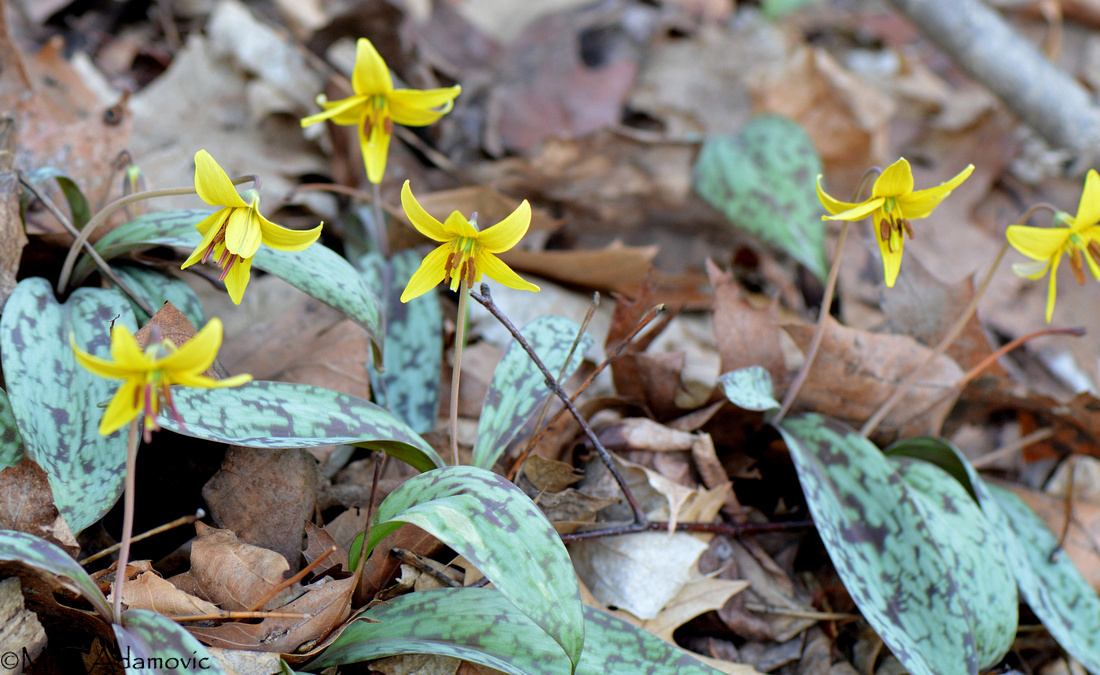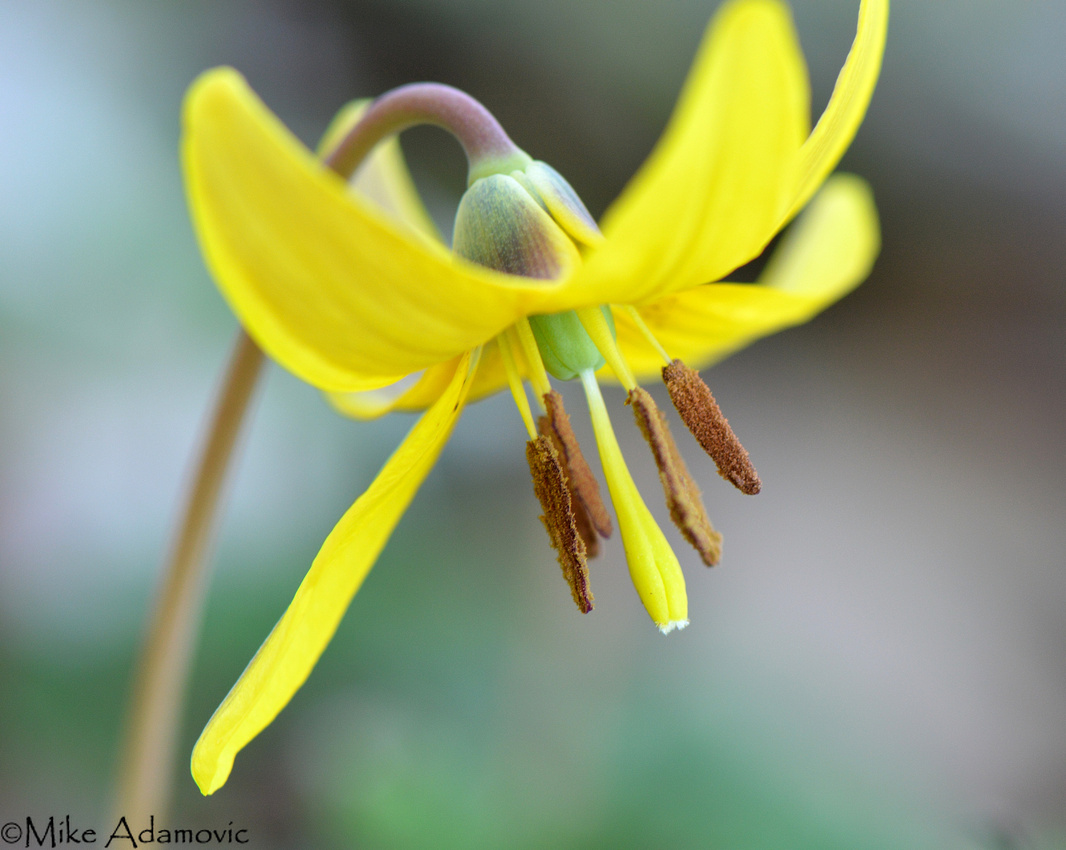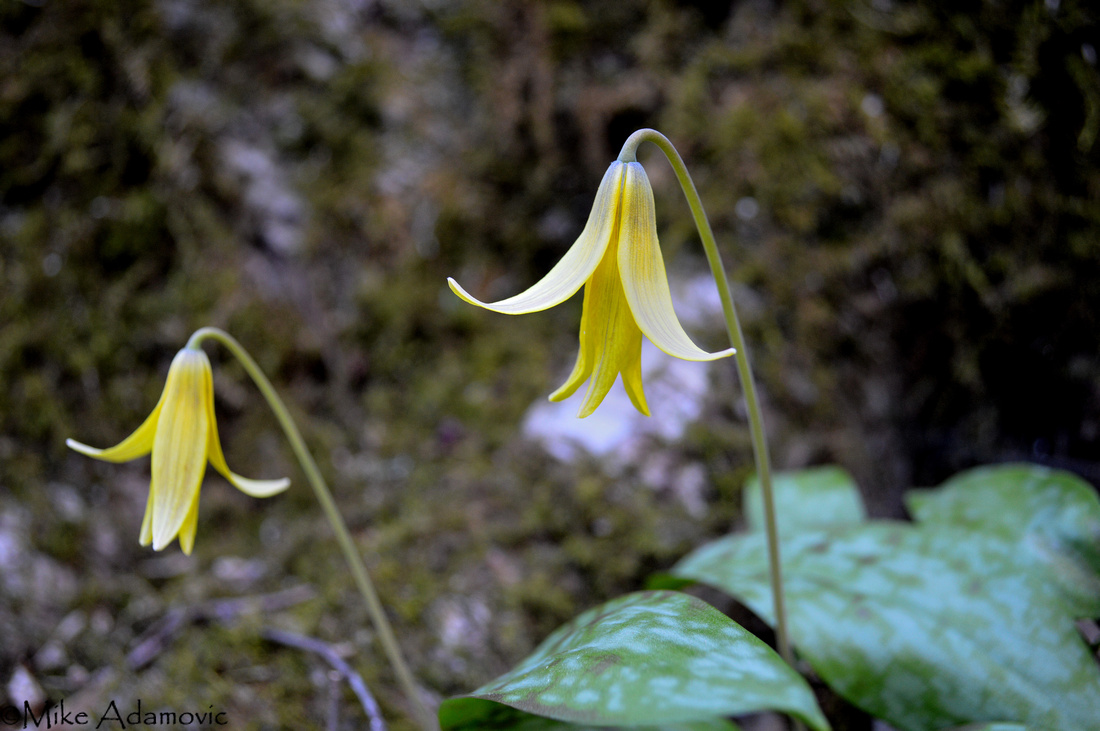Trout Lily (Erythronium americanum)


From April until the early days of May arrays of trout lilies decorate the understory of rich, moist forests and along gravelly floodplains. While this common spring ephemeral often forms large colonies consisting of the hundreds or thousands of individuals, its waxy, mottled leaves and unique nodding blossoms endowed with a cheery sun-yellow hue are sure to delight whoever happens to encounter them during the first half of the spring season. Nothing is lost in the abundance. These elegant and graceful, almost sculpture-like flowers, greatly supersede the similarly colored weedy dandelion that's apt to rear up its unwanted head around the same time.
The yellow trout lily (Erythronium americanum), aside from being "the earliest of the lilies" is also "one of the most pleasing," according to the naturalist John Burroughs. Along with its "most beautiful" physical appeal, it's also layered in a cloak of intrigue, with its many curious traits which aren't always readily understood. In this respect, he most emphatically voiced that the "botanist, or nature-lover, will find here a field for original research."
While the anatomy and habits of the trout lily at times both perplexed and astounded Burroughs, the nomenclature of this species perhaps made him scratch his head the more. Up until the early days of the 20th century, this plant boasted a plethora of names, a few of which, really didn't fit the plant at all. "It is a pity that this graceful and abundant flower," Burroughs lamented, "has no good and appropriate common name." "Dog-tooth violet" and "adder's-tongue" were most frequently used. He put forth a flurry of theories as to why these names were bestowed. In terms of the dog-tooth violet appellation, he theorized that the color and shape of the unopened buds resembled canine teeth; yet the violet part puzzled him, as it "has not one feature of a violet." Others have suggested it's so-called due to the shape of the plant's corms. Adder's-tongue, he thought derived from the "spotted character of the leaf," because it vaguely resembles the patterns on the skin of some snakes. The wildflower expert, Neltje Blanchan, on the other hand, proposed that the name comes from the "sharp purplish point" of young plants as they first emerge above ground, clearly resembling a little serpentine tongue.

 E. americanum has also been called lamb's-tongue, snakeroot, yellow snowdrop, yellow bells, yellow lily, among other similarly descriptive monikers. Burroughs propounded the name trout lily, and is generally credited with its now widespread use. In his book, Riverby, he concisely stated: "It blooms along the trout streams, and its leaf is as mottled as a trout's back." He was also fond of "fawn lily" too, once again in relation to the spotted nature of the leaves.
E. americanum has also been called lamb's-tongue, snakeroot, yellow snowdrop, yellow bells, yellow lily, among other similarly descriptive monikers. Burroughs propounded the name trout lily, and is generally credited with its now widespread use. In his book, Riverby, he concisely stated: "It blooms along the trout streams, and its leaf is as mottled as a trout's back." He was also fond of "fawn lily" too, once again in relation to the spotted nature of the leaves.
Trout lilies, like many other spring ephemerals, are able to produce blossoms so early in the spring season through use of the energy reserves stored in the root-like corms. Expansive, long-lived colonies often develop in areas of prime habitat. The average age of most colonies is about 150; some have been shown to be 1,300 years old. Though these plants often carpet the forest floor with their mottled leaves, don't expect to come across a sea of yellow flowers. It's been estimated than only 1% of plants will bloom. This is probably due to the fact that trout lilies rely more on vegetative propagation than they do by means of seeds.


Only older plants that have two leaves possess the capability to bloom. It generally takes between 4-7 years for these lilies to fully mature. Each year the corms grow slightly larger and creep downward through the soil. Digging some up for inspection, John Burroughs discovered that the corms of young plants were barely two inches deep, in contrast to the flowering individuals that had progressed to a depth of 8 inches.
Trout lilies are dimorphic when it comes to their pollen-bearing anthers. The more common variety has lemon-yellow anthers, while the variant, Erythronium var. rubrum bears a set that's red-brown. The latter type, according to Oliver Farwell, is additionally, "one third to one half larger in all its parts." He further mentions slight differences of the stigmas. "The smaller one," he notes, has "mostly entire stigmas," while the red-anthered variety's "stigma is usually three-lobed."
Compared to other spring ephemerals the blossoms of the trout lily are fairly demure, nodding towards the ground as if still drowsy from its long winter slumber beneath the chilled ground, rather than bursting with exuberance like hepatica, bloodroot, and spring beauty, that eagerly and unabashedly push their heads high to all the world. Though these plants boast a seemingly unenthusiastic demeanor, having its flowers point downward is actually a clever tactic that ensures higher rates of reproductive success. By facing down, each blossom acts as a miniature umbrella, keeping valuable pollen from being washed away during the frequent rainstorms that are apt to inundate the early spring landscape. And secondly, it prevents unwanted insects that play no role in pollination from stealing the precious nectar and pollen. "Crawling pilferers," Neltje Blanchan explains, "rarely think it worth the while to slip and slide up the smooth footstalk and risk a tumble where it curves to allow the flower to nod."
Trout lilies are highly ecologically valuable. Colonies play a vital function with cutting down on erosion—masses of long, tangled roots, keep soil held in place, and the numerous leaves that dot the understory lessen the impact of falling water, by acting as a leafy shield. Plants are also excellent at absorbing and sequestering the important nutrient, phosphorus. In mid-summer when the plants go dormant, the withered leaves release this element back into the soil, essentially fertilizing it. And lastly, along with providing for insects, black bears also gain a meal from trout lily colonies by digging up and stuffing themselves with the starchy underground corms.
While wildlife such as bears relish the roots, this is one species not for human consumption. Medicinally, the corms have been used in years past as a powerful emetic (causes vomiting). Native Americans collected the corms to use as a poultice for ulcers, tumors, and skin inflammations, such as hives. The leaves were also brewed into a tea supposedly useful for treating hiccups. An 1828 medical botany text by Constantine Rafinesque says that "fresh roots and leaves" that are "stewed with milk and applied to... scrofulous sores [tuberculous infections of the neck]” will be quickly healed. While little, if seldom used, for any of these purposes now, it's good to know that if the need for such a remedy ever arises while out among the wilderness, it can easily be found quietly thriving among the understory of freshly greened forests.
Abundant and widespread, trout lilies inhabit the entire eastern half of the country, from the Atlantic Coast to the Mississippi River, from southern Georgia to Canada. It's therefore not difficult in the least to come across one of these impressively beautiful and "dainty little lilies" imbued with a "faint fragrance that suggests a tulip." But, similarly to the other spring ephemeral wildflowers, trout lilies have fleeting lives so it's necessary not to delay a trip to the woods in the early spring. Come the height of summer not even the artful mottled leaves remain, the plants having gone entirely dormant until the following year. Robert Herrick reminds us of the importance of this in the first stanza of his well-known poem:
GATHER ye rosebuds while ye may,
Old Time is still a-flying:
And this same flower that smiles to-day
To-morrow will be dying.

